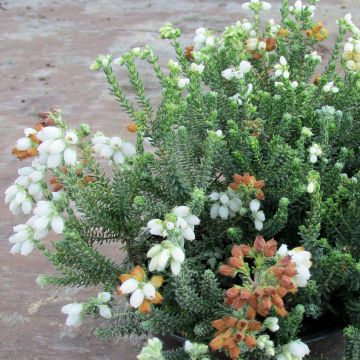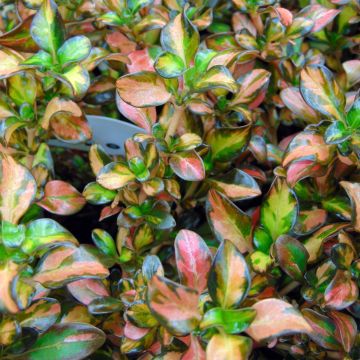

Garrya thuretii - Garrya de Thuret


Garrya thuretii - Garrya de Thuret


Garrya thuretii - Garrya de Thuret
Garrya x thuretii - Hybrid Garrya
Garrya x thuretii
Hybrid Garrya
Special offer!
Receive a €20 voucher for any order over €90 (excluding delivery costs, credit notes, and plastic-free options)!
1- Add your favorite plants to your cart.
2- Once you have reached €90, confirm your order (you can even choose the delivery date!).
3- As soon as your order is shipped, you will receive an email containing your voucher code, valid for 3 months (90 days).
Your voucher is unique and can only be used once, for any order with a minimum value of €20, excluding delivery costs.
Can be combined with other current offers, non-divisible and non-refundable.
Home or relay delivery (depending on size and destination)
Schedule delivery date,
and select date in basket
This plant carries a 24 months recovery warranty
More information
We guarantee the quality of our plants for a full growing cycle, and will replace at our expense any plant that fails to recover under normal climatic and planting conditions.
Would this plant suit my garden?
Set up your Plantfit profile →
Description
The Garrya (x) thuretii is a vigorous evergreen bush that allows for expanding the range of hedge plants in coastal gardens or in our mild regions, because its cold resistance is limited. Less spectacular than those of its parent, the Garrya elliptica, its winter flowering in slender pendulous yellowish-gray aments brings a little life to the garden, while its evergreen foliage protects it from gusts of wind. The plant is rather accommodating; it tolerates slightly calcareous soils, sea spray, and even summer drought once established in deep soil. Plant this bush in partial shade, as it dreads scorching exposures.
The Garrya (x) thuretii is a bush in the garryaceae family. It is a horticultural hybrid resulting from the cross-breeding between Garrya elliptica and G. fadyenii obtained in Antibes in 1882 by Gustave Thuret. It grows rapidly, with a ramified and bushy habit, reaching on average 4m (13 ft 1 in) in height and 4.50m (14 ft 10 in) in spread at maturity. It is a dioecious bush, with female and male individuals, the latter being more cultivated in gardens due to their more decorative flowering. Its parents are native to forests on the west coast of the United States, particularly from an area that extends from southern Oregon to central California. It is a host of the chaparral, a shrubby formation similar to our Corsican maquis. It is a plant of a rather dry summer and relatively mild climate. The foliage, theoretically evergreen, will be damaged at the first frost.
The branches of Thuret's Garrya bear leathery elliptical leaves arranged in an opposite manner. They are 6 to 10cm (2.4 to 3.9 in) long and 2 to 3cm (0.8 to 1.2 in) wide, dark green and satin-like on the upper side, almost gray and pubescent underneath. The bush will be able to flower at the age of 5 or 6 years. Flowering usually takes place in February, or until March-April, depending on the climate. The inflorescences are long trailing aments that appear at the axils of the leaves. They are composed of a stack of small yellowish flowers enveloped in a silky bract, gray with silver reflections. The female aments are shorter and erect. The female plants will bear spherical berries of a purple-brown colour in the presence of male plants.
Well sheltered from cold winds, Garrya thuretii is hardy down to -10°C, in properly drained soil. So be vigilant with regards to heavy frosts. On the other hand, it will adapt very well to the mild oceanic climate offered by the Southwest and Brittany, where it will tolerate sea spray perfectly. It will also be more comfortable in a warmer urban garden that is better protected from cold winds than in a plain. Its behavior in a Mediterranean climate is also satisfactory, even without summer watering once well established, provided it is planted in partial shade and in deep soil. It is preferably planted as a free-standing hedge to make the most of its dark and dense branches, which often descend to the ground, illuminated by the pale aments. It can be associated with strawberry trees, tall Olearia, evergreen oaks, Photinias, Elaeagnus, and other Rhamnus alaternus to create an effective and decorative windbreak throughout the year.
Report an error about the product description
Garrya x thuretii - Hybrid Garrya in pictures




Plant habit
Flowering
Foliage
Botanical data
Garrya
x thuretii
Garryaceae
Hybrid Garrya
Cultivar or hybrid
Planting and care
Choose a suitable location for your Garrya thuretii, as it does not tolerate transplantation well. It will prefer a sunny spot in the north of the country, but partially shaded in hot climates. Choose a location sheltered from cold winter winds that could harm its hardiness and damage its beautiful flowering. Plant it in ordinary soil, but deep enough and well-drained. It is essential to add coarse sand and leaf compost to the planting hole if your soil tends to be clayey and compact. This plant is not very sensitive to soil pH, which can be slightly acidic, neutral, or slightly alkaline. Water generously (at least 1 11-liter watering can) but spaced out during periods of drought, for the first two or three summers. The bush will then do without watering, even in hot regions if it is well-rooted. Its hardiness is around -10°C (14 °F) at its most extreme, for a well-established plant in a sheltered position.
Protect your young bush with a thick mulch and winter protection in areas close to its hardiness limit or in case of severe frost. Optionally, apply a thick mulch around the base of the plant in summer to keep the soil cool. Do not prune your bush excessively, as it would affect its flowering. You can remove dead wood and some branches in April to rebalance its shape.
The main disease affecting Garrya is black spot, caused by a fungus that develops on the leaves in warm and humid weather. Avoid watering the foliage.
Planting period
Intended location
Care
This item has not been reviewed yet - be the first to leave a review about it.
Similar products
Haven't found what you were looking for?
Hardiness is the lowest winter temperature a plant can endure without suffering serious damage or even dying. However, hardiness is affected by location (a sheltered area, such as a patio), protection (winter cover) and soil type (hardiness is improved by well-drained soil).

Photo Sharing Terms & Conditions
In order to encourage gardeners to interact and share their experiences, Promesse de fleurs offers various media enabling content to be uploaded onto its Site - in particular via the ‘Photo sharing’ module.
The User agrees to refrain from:
- Posting any content that is illegal, prejudicial, insulting, racist, inciteful to hatred, revisionist, contrary to public decency, that infringes on privacy or on the privacy rights of third parties, in particular the publicity rights of persons and goods, intellectual property rights, or the right to privacy.
- Submitting content on behalf of a third party;
- Impersonate the identity of a third party and/or publish any personal information about a third party;
In general, the User undertakes to refrain from any unethical behaviour.
All Content (in particular text, comments, files, images, photos, videos, creative works, etc.), which may be subject to property or intellectual property rights, image or other private rights, shall remain the property of the User, subject to the limited rights granted by the terms of the licence granted by Promesse de fleurs as stated below. Users are at liberty to publish or not to publish such Content on the Site, notably via the ‘Photo Sharing’ facility, and accept that this Content shall be made public and freely accessible, notably on the Internet.
Users further acknowledge, undertake to have ,and guarantee that they hold all necessary rights and permissions to publish such material on the Site, in particular with regard to the legislation in force pertaining to any privacy, property, intellectual property, image, or contractual rights, or rights of any other nature. By publishing such Content on the Site, Users acknowledge accepting full liability as publishers of the Content within the meaning of the law, and grant Promesse de fleurs, free of charge, an inclusive, worldwide licence for the said Content for the entire duration of its publication, including all reproduction, representation, up/downloading, displaying, performing, transmission, and storage rights.
Users also grant permission for their name to be linked to the Content and accept that this link may not always be made available.
By engaging in posting material, Users consent to their Content becoming automatically accessible on the Internet, in particular on other sites and/or blogs and/or web pages of the Promesse de fleurs site, including in particular social pages and the Promesse de fleurs catalogue.
Users may secure the removal of entrusted content free of charge by issuing a simple request via our contact form.
The flowering period indicated on our website applies to countries and regions located in USDA zone 8 (France, the United Kingdom, Ireland, the Netherlands, etc.)
It will vary according to where you live:
- In zones 9 to 10 (Italy, Spain, Greece, etc.), flowering will occur about 2 to 4 weeks earlier.
- In zones 6 to 7 (Germany, Poland, Slovenia, and lower mountainous regions), flowering will be delayed by 2 to 3 weeks.
- In zone 5 (Central Europe, Scandinavia), blooming will be delayed by 3 to 5 weeks.
In temperate climates, pruning of spring-flowering shrubs (forsythia, spireas, etc.) should be done just after flowering.
Pruning of summer-flowering shrubs (Indian Lilac, Perovskia, etc.) can be done in winter or spring.
In cold regions as well as with frost-sensitive plants, avoid pruning too early when severe frosts may still occur.
The planting period indicated on our website applies to countries and regions located in USDA zone 8 (France, United Kingdom, Ireland, Netherlands).
It will vary according to where you live:
- In Mediterranean zones (Marseille, Madrid, Milan, etc.), autumn and winter are the best planting periods.
- In continental zones (Strasbourg, Munich, Vienna, etc.), delay planting by 2 to 3 weeks in spring and bring it forward by 2 to 4 weeks in autumn.
- In mountainous regions (the Alps, Pyrenees, Carpathians, etc.), it is best to plant in late spring (May-June) or late summer (August-September).
The harvesting period indicated on our website applies to countries and regions in USDA zone 8 (France, England, Ireland, the Netherlands).
In colder areas (Scandinavia, Poland, Austria...) fruit and vegetable harvests are likely to be delayed by 3-4 weeks.
In warmer areas (Italy, Spain, Greece, etc.), harvesting will probably take place earlier, depending on weather conditions.
The sowing periods indicated on our website apply to countries and regions within USDA Zone 8 (France, UK, Ireland, Netherlands).
In colder areas (Scandinavia, Poland, Austria...), delay any outdoor sowing by 3-4 weeks, or sow under glass.
In warmer climes (Italy, Spain, Greece, etc.), bring outdoor sowing forward by a few weeks.








































